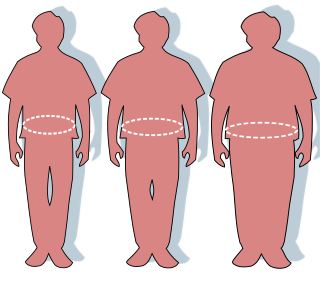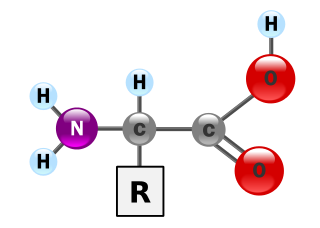
Obesity is a medical condition, sometimes considered a disease, in which excess body fat has accumulated to such an extent that it can potentially have negative effects on health. People are classified as obese when their body mass index (BMI)—a person's weight divided by the square of the person's height—is over 30 kg/m2; the range 25–30 kg/m2 is defined as overweight. Some East Asian countries use lower values to calculate obesity. Obesity is a major cause of disability and is correlated with various diseases and conditions, particularly cardiovascular diseases, type 2 diabetes, obstructive sleep apnea, certain types of cancer, and osteoarthritis.
An essential amino acid, or indispensable amino acid, is an amino acid that cannot be synthesized from scratch by the organism fast enough to supply its demand, and must therefore come from the diet. Of the 21 amino acids common to all life forms, the nine amino acids humans cannot synthesize are valine, isoleucine, leucine, methionine, phenylalanine, tryptophan, threonine, histidine, and lysine.
Food energy is chemical energy that animals derive from their food to sustain their metabolism, including their muscular activity.
Basal metabolic rate (BMR) is the rate of energy expenditure per unit time by endothermic animals at rest. It is reported in energy units per unit time ranging from watt (joule/second) to ml O2/min or joule per hour per kg body mass J/(h·kg). Proper measurement requires a strict set of criteria to be met. These criteria include being in a physically and psychologically undisturbed state and being in a thermally neutral environment while in the post-absorptive state (i.e., not actively digesting food). In bradymetabolic animals, such as fish and reptiles, the equivalent term standard metabolic rate (SMR) applies. It follows the same criteria as BMR, but requires the documentation of the temperature at which the metabolic rate was measured. This makes BMR a variant of standard metabolic rate measurement that excludes the temperature data, a practice that has led to problems in defining "standard" rates of metabolism for many mammals.

Anaerobic exercise is a type of exercise that breaks down glucose in the body without using oxygen; anaerobic means "without oxygen". In practical terms, this means that anaerobic exercise is more intense, but shorter in duration than aerobic exercise. This type of exercise leads to a buildup of lactic acid.
Resting metabolic rate (RMR) is whole-body mammal metabolism during a time period of strict and steady resting conditions that are defined by a combination of assumptions of physiological homeostasis and biological equilibrium. RMR differs from basal metabolic rate (BMR) because BMR measurements must meet total physiological equilibrium whereas RMR conditions of measurement can be altered and defined by the contextual limitations. Therefore, BMR is measured in the elusive "perfect" steady state, whereas RMR measurement is more accessible and thus, represents most, if not all measurements or estimates of daily energy expenditure.
The metabolic equivalent of task (MET) is the objective measure of the ratio of the rate at which a person expends energy, relative to the mass of that person, while performing some specific physical activity compared to a reference, currently set by convention at an absolute 3.5 mL of oxygen per kg per minute, which is the energy expended when sitting quietly by a reference individual, chosen to be roughly representative of the general population, and thereby suited to epidemiological surveys. A Compendium of Physical Activities is available online, which provides MET values for hundreds of activities.
Protein digestibility-corrected amino acid score (PDCAAS) is a method of evaluating the quality of a protein based on both the amino acid requirements of humans and their ability to digest it.
The Schofield Equation is a method of estimating the basal metabolic rate (BMR) of adult men and women published in 1985.
Energy consumption is the amount of energy used.
General fitness training works towards broad goals of overall health and well-being, rather than narrow goals of sport competition, larger muscles or concerns over appearance. A regular moderate workout regimen and healthy diet can improve general appearance markers of good health such as muscle tone, healthy skin, hair and nails, while preventing age or lifestyle-related reductions in health and the series of heart and organ failures that accompany inactivity and poor diet.
Biological value (BV) is a measure of the proportion of absorbed protein from a food which becomes incorporated into the proteins of the organism's body. It captures how readily the digested protein can be used in protein synthesis in the cells of the organism. Proteins are the major source of nitrogen in food. BV assumes protein is the only source of nitrogen and measures the amount of nitrogen ingested in relation to the amount which is subsequently excreted. The remainder must have been incorporated into the proteins of the organisms body. A ratio of nitrogen incorporated into the body over nitrogen absorbed gives a measure of protein "usability" – the BV.

Proteins are essential nutrients for the human body. They are one of the building blocks of body tissue and can also serve as a fuel source. As a fuel, proteins provide as much energy density as carbohydrates: 4 kcal per gram; in contrast, lipids provide 9 kcal per gram. The most important aspect and defining characteristic of protein from a nutritional standpoint is its amino acid composition.
Starvation response in animals is a set of adaptive biochemical and physiological changes, triggered by lack of food or extreme weight loss, in which the body seeks to conserve energy by reducing metabolic rate and/or non-resting energy expenditure to prolong survival and preserve body fat and lean mass.
The Harris–Benedict equation is a method used to estimate an individual's basal metabolic rate (BMR).

Diet plays an important role in the genesis of obesity. Personal choices, food advertising, social customs and cultural influences, as well as food availability and pricing all play a role in determining what and how much an individual eats.
In biology, energy homeostasis, or the homeostatic control of energy balance, is a biological process that involves the coordinated homeostatic regulation of food intake and energy expenditure. The human brain, particularly the hypothalamus, plays a central role in regulating energy homeostasis and generating the sense of hunger by integrating a number of biochemical signals that transmit information about energy balance. Fifty percent of the energy from glucose metabolism is immediately converted to heat.

Weight management refers to behaviors, techniques, and physiological processes that contribute to a person's ability to attain and maintain a healthy weight. Most weight management techniques encompass long-term lifestyle strategies that promote healthy eating and daily physical activity. Moreover, weight management involves developing meaningful ways to track weight over time and to identify the ideal body weights for different individuals.
A caloric deficit is any shortage in the number of calories consumed relative to the number of calories needed for maintenance of current body weight.
Energy expenditure, often estimated as the total daily energy expenditure (TDEE), is the amount of energy burned by the human body.






